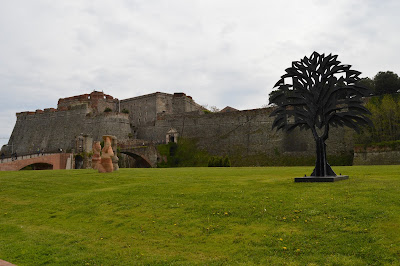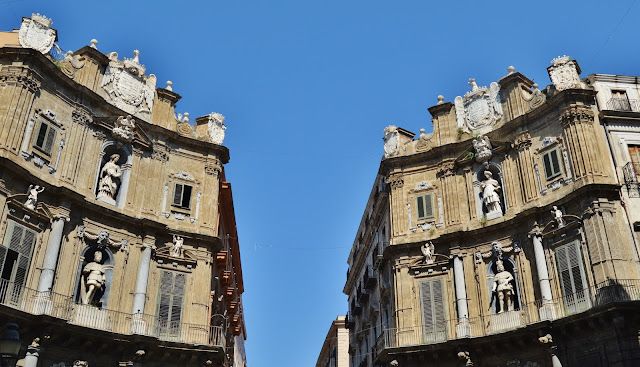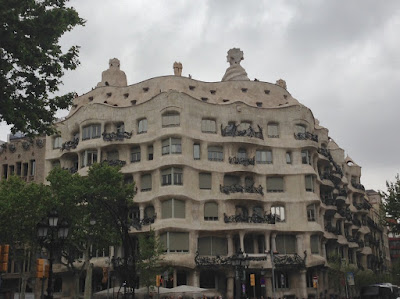Mid-April we flew to Barcelona, Spain, meeting up with John's parents for a 7 night Western Mediterranean cruise aboard the Costa Fascinosa. The Fascinosa is a relatively new ship, built in 2012 with a passenger capacity of 3,780. We chose this cruise because the itinerary visited 5 out of 6 ports that we had never been to before. (Malta was one of our favorite ports from our cruise last year, so we didn't mind visiting again.)
Day 1
Setting sail from Barcelona, we enjoyed the view, beautiful water and watching the seagulls follow the ship out of port.


Day 2















We then took a walk around the town, taking pictures and enjoying some pizza before we headed back to the ship.
Savona was a good first day starter place. There wasn't much to see but it was a pleasant city to visit.
Day 3
Civitavecchia, Rome, Italy
We booked a coach tour to Rome for the day. The ride from the port to Rome was about an hour. We enjoyed the beautiful scenery of water, hills and grapes along the way.
Our first stop for the day was Vatican City, visiting the Vatican Museums, the Sistine Chapel and St. Peter's Basilica.




St. Peter's Basilica


Arch of Constantine
The Arch of Constantine was erected by the Roman Senate to commemorate Constantine I's victory over Maxentius at the Battle of Milvian Bridge on October 28, 312.

The Colosseum (Flavian Amphitheatre)
The Colosseum construction began in 72 AD, and was completed in 80 AD. It is the largest amphitheatre ever built and is considered one of the greatest works of architecture and engineering. The Colosseum could hold, it is estimated, between 50,000 and 80,000 spectators. It was used for gladiatorial contests and public spectacles such as mock sea battles, animal hunts, executions, re-enactments of famous battles, and dramas based on classical mythology.


Originally the site of the Forum had been marshy lake where waters from the surrounding hills drained. Because of its location, sediments from both the flooding of the Tiber River and the erosion of the surrounding hills have been raising the level of the Forum floor for centuries. As the ground around buildings began to rise, residents simply paved over the debris that was too much to remove. Its final travertine paving, still visible, dates from the reign of Augustus. Excavations in the 19th century revealed one layer on top of another. The deepest level excavated was 3.60 meters above sea level.
Piazza del Campidoglio on Capitoline Hill
Piazza del Campidoglio was designed by Michelangelo in 1536–1546.
The plaza houses the Capitoline Museums and Senatorial Palace (Rome City Hall). The Capitoline Museums opened to the public in 1734 and are considered to be the first museums in the world where art could be enjoyed by all and not only by the owners.




Romulus and Remus statue. Twin brothers Romulus and Remus with mother wolf Rhea Silvia.
We really enjoyed our visit to Rome and Vatican City. For a short 1 day visit we really got to see a lot, but feel as if we could definitely go back for another visit.
Day 4
Palermo, Sicily



Upon arriving in port in Palermo we decided to hire a guided Ape Tour. The 'Moto Ape' is a 3 wheeled small cart-like vehicle.
Quattro Canti, Piazza Vigliena
An octagonal Baroque square, built between 1608-1620. Four of the sides are the streets and the remaining four sides are Baroque buildings. The facades of each building contain fountains with statues of the four seasons, the four Spanish kings of Sicily, and of the four patronesses of Palermo.


South-Spring-Charles V-Cristina di Bolsena West-Summer-Philip II-Santa Ninfa
Day 1
Setting sail from Barcelona, we enjoyed the view, beautiful water and watching the seagulls follow the ship out of port.


Day 2
Savona, Italy


We decided to do a self guided walking tour of the city. Our first stop was the Fortezza del Priamar (Priamar Fortress). The fortress was built in 1542 by the Republic of Genoa on the large hill above the city of Savona.













Savona was a good first day starter place. There wasn't much to see but it was a pleasant city to visit.
Day 3
Civitavecchia, Rome, Italy
We booked a coach tour to Rome for the day. The ride from the port to Rome was about an hour. We enjoyed the beautiful scenery of water, hills and grapes along the way.
Our first stop for the day was Vatican City, visiting the Vatican Museums, the Sistine Chapel and St. Peter's Basilica.
Vatican Museums




Vatican City


We then got back on the coach to head to our lunch destination. After lunch we headed to the Colosseum, admiring the views along the way.
The Mausoleum of Hadrian
(Castel Sant'Angelo (English: Castle of the Holy Angel))
Vittoriano Monument
(or as the Romans call it 'the wedding cake')Arch of Constantine
The Arch of Constantine was erected by the Roman Senate to commemorate Constantine I's victory over Maxentius at the Battle of Milvian Bridge on October 28, 312.

The Colosseum (Flavian Amphitheatre)
The Colosseum construction began in 72 AD, and was completed in 80 AD. It is the largest amphitheatre ever built and is considered one of the greatest works of architecture and engineering. The Colosseum could hold, it is estimated, between 50,000 and 80,000 spectators. It was used for gladiatorial contests and public spectacles such as mock sea battles, animal hunts, executions, re-enactments of famous battles, and dramas based on classical mythology.


The Roman Forum
The Roman Forum is a rectangular plaza surrounded by the ruins of several important ancient government buildings. It was for centuries the center of Roman public life: the site of triumphal processions and elections, the venue for public speeches, criminal trials, and gladiatorial matches and the nucleus of commercial affairs. Originally the site of the Forum had been marshy lake where waters from the surrounding hills drained. Because of its location, sediments from both the flooding of the Tiber River and the erosion of the surrounding hills have been raising the level of the Forum floor for centuries. As the ground around buildings began to rise, residents simply paved over the debris that was too much to remove. Its final travertine paving, still visible, dates from the reign of Augustus. Excavations in the 19th century revealed one layer on top of another. The deepest level excavated was 3.60 meters above sea level.
Piazza del Campidoglio on Capitoline Hill
Piazza del Campidoglio was designed by Michelangelo in 1536–1546.
The plaza houses the Capitoline Museums and Senatorial Palace (Rome City Hall). The Capitoline Museums opened to the public in 1734 and are considered to be the first museums in the world where art could be enjoyed by all and not only by the owners.




Romulus and Remus statue. Twin brothers Romulus and Remus with mother wolf Rhea Silvia.
We really enjoyed our visit to Rome and Vatican City. For a short 1 day visit we really got to see a lot, but feel as if we could definitely go back for another visit.
Day 4



Upon arriving in port in Palermo we decided to hire a guided Ape Tour. The 'Moto Ape' is a 3 wheeled small cart-like vehicle.
Piazza Marina
Piazza Marina is home to famous the Moreton Bay Fig (Ficus Macrophyla) Tree. It was planted in the year 1863, making it 152 yrs old. It is the biggest and oldest in Palermo and all of Europe. It stands at 82 ft tall and a trunk Girth / central Body of 131 ft around.Quattro Canti, Piazza Vigliena
An octagonal Baroque square, built between 1608-1620. Four of the sides are the streets and the remaining four sides are Baroque buildings. The facades of each building contain fountains with statues of the four seasons, the four Spanish kings of Sicily, and of the four patronesses of Palermo.


South-Spring-Charles V-Cristina di Bolsena West-Summer-Philip II-Santa Ninfa
Autumn-North-Philip IV-Oliva di Palermo Winter-East-Philip III-Sant'Agata



Day 5
Valletta, Malta
Upon arriving in Valletta, we hopped on a bus to spend the day in Mdina. Mdina is a medieval walled city dating back to 60 A.D. It is situated on a hill in the center of the island and served as the island's capital until 1530. The town is still confined within its walls, and has a population of just under 300.









This was our 2nd visit to the island of Malta, seeing different areas both times. It is a beautiful place and would still put it on our list to visit again.
Day 6
At Sea
A day to rest, explore the ship, play some bingo & slot machines, see a few shows, read a book and get a bit of sunshine.








Day 7
Palma, Majorca
Palma de Mallorca
Balearic Islands, Spain

In Mallorca we booked a shore excursion to the Cuevas del Drach (Dragon Caves). It consist of four caves and an underground lake.
First written record of the caves dates back to a message from Rover de Rovenach to the mayor in 1338.








Since we booked our cave tour we didn't get to spend any time in Palma. It looked like a great seaside vacation destination, and wouldn't mind coming back for another visit.
Day 8
Barcelona, Spain
We arrived back in Barcelona and spent 2 nights exploring the beautiful city. Barcelona is an amazing city with stunning architecture everywhere you looked.





Barcelona Olympic Stadium




Arc de Triomf









Sagrada Família
The Sagrada Família is a large Roman Catholic church designed by Catalan architect Antoni Gaudí. Construction of Sagrada Família started in 1882 and Gaudí became involved in 1883, taking over the project and transforming it with his architectural and engineering style, combining Gothic and curvilinear Art Nouveau forms. Gaudí devoted his last years to the project, and at the time of his death at the age of 73 in 1926, less than a quarter of the project was complete. The construction progressed slowly, as it relied on private donations and was interrupted by the Spanish Civil War, only to resume intermittent progress in the 1950's. Construction passed the midpoint in 2010 with some of the project's greatest challenges remaining. The anticipated completion date of 2026 is the centenary of Gaudí's death.






It was an amazing site to see with so much detail in the architecture, you could look at it for hours and still see something new.


Palermo Cathedral erected in 1185.

Teatro Massimo Vittorio Emanuele Opera House
Constructed from 1874–1897 Opened in 1897
(The final scenes of the film The Godfather Part III were filmed at the theatre.)
Palermo had some interesting sights to see (both good and bad). If we were to return to Sicily we would definitely want to get out of the city and see more of the island and its beautiful coastlines.Day 5
Valletta, Malta
Upon arriving in Valletta, we hopped on a bus to spend the day in Mdina. Mdina is a medieval walled city dating back to 60 A.D. It is situated on a hill in the center of the island and served as the island's capital until 1530. The town is still confined within its walls, and has a population of just under 300.









This was our 2nd visit to the island of Malta, seeing different areas both times. It is a beautiful place and would still put it on our list to visit again.
Day 6
At Sea
A day to rest, explore the ship, play some bingo & slot machines, see a few shows, read a book and get a bit of sunshine.








Day 7
Palma, Majorca
Palma de Mallorca
Balearic Islands, Spain

In Mallorca we booked a shore excursion to the Cuevas del Drach (Dragon Caves). It consist of four caves and an underground lake.
First written record of the caves dates back to a message from Rover de Rovenach to the mayor in 1338.





Our visit ended with a short classical concert performed by four musicians on a boat in the middle of the lake.



Since we booked our cave tour we didn't get to spend any time in Palma. It looked like a great seaside vacation destination, and wouldn't mind coming back for another visit.
Day 8
Barcelona, Spain
We arrived back in Barcelona and spent 2 nights exploring the beautiful city. Barcelona is an amazing city with stunning architecture everywhere you looked.





Barcelona Olympic Stadium




Arc de Triomf









Sagrada Família
The Sagrada Família is a large Roman Catholic church designed by Catalan architect Antoni Gaudí. Construction of Sagrada Família started in 1882 and Gaudí became involved in 1883, taking over the project and transforming it with his architectural and engineering style, combining Gothic and curvilinear Art Nouveau forms. Gaudí devoted his last years to the project, and at the time of his death at the age of 73 in 1926, less than a quarter of the project was complete. The construction progressed slowly, as it relied on private donations and was interrupted by the Spanish Civil War, only to resume intermittent progress in the 1950's. Construction passed the midpoint in 2010 with some of the project's greatest challenges remaining. The anticipated completion date of 2026 is the centenary of Gaudí's death.






It was an amazing site to see with so much detail in the architecture, you could look at it for hours and still see something new.
We thoroughly enjoyed our stay in Barcelona, we were very surprised at how big the city was, yet it was very clean and pedestrian and bicyclist friendly.
Well that's it for our tour of the Western Mediterranean. We had a wonderful time and really enjoyed getting to share this experience with John's parents.
Look for our next blog on our visit with CJ's best friend, LoriAnna and our travels to the Isle of Mull, Iona and Staffa, and CJ and LoriAnna's trip to Paris and London.
Cheers and much love to our family and friends!
John and CJ










































































































Loved all the beautiful pictures. I felt like I was there. Thanks for sharing.
ReplyDeleteYeh me too! You guys look like you're having the time of your life! I wanna be you when I grow up!
ReplyDelete